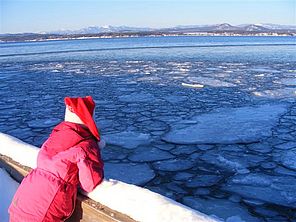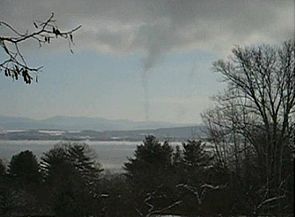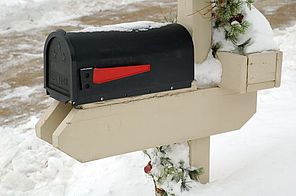Lake Ripples - January 2010
LCC's E-News Bulletin
Natural History Note – Lake Ice

Clear, cold, windless nights present ideal conditions for the actual freezing of ponds and lakes. The clear skies mean no cloud cover blanket to trap heat radiated away from the earth overnight. Colder air allows more heat to be transferred from the water. Absence of wind means that once the ice begins to form, wave action stirred by the wind will not interrupt the process.
Different bodies of water freeze at different times, and three of the principle factors influencing which lakes freeze and which don’t are the lake's location, volume, and area. Obviously a lake in Florida is less likely to freeze than a lake in the Northeast, but the other aspect of location is altitude. Colder temperatures at higher elevations make lakes in the mountains more likely to freeze. Volume is another relatively obvious factor. It takes more time and colder air temperatures to draw the heat out of a large volume of water than it does a small volume of water. For that reason, fairly small lakes that are very deep will take much longer to freeze. The influence of lake area is a little less obvious, but the expanse of a flat treeless surface provides no hindrance to gathering winds, which can break up the ice as it forms. Thus, large lakes will freeze more slowly than small lakes of a similar volume. MORE
Lake Look ~ Steam Devils

Throughout the winter, arctic air masses move in over Lake Champlain. Frequently, a layer of fog develops at the interface between air and water. At first the fog is formless, but then a few strands will be pulled upward in strings like cotton candy. The wisps of steam carry heat and moisture to the air above. Occasionally, some of these strings begin to spiral and become taller and tighter, stretching up above the fog layer. The thin tubes are typically only a few feet wide, but can get much larger. The tubes can reach up to a hundred feet into the air, like small tornados over the lake.
The whirlwinds, usually referred to as steam devils, form via the same process that creates the little dust devils that whip across a parking lot or driveway on a summer’s day. It requires a layer of cold air sitting over a layer of warm air, and a breeze or wind. For the dust devils, the blacktop of the driveway absorbs sunlight and creates a warm layer underneath the air above it. For the steam devils, the warm lake underneath the arctic air mass provides the warmth. MORE
Please Keep Us Posted on Your Address Changes

If your mail or email address has changed recently, please send us an email so we can correct your files and ensure that we keep you updated on lake issues and LCC’s work. LCC’s primary form of communication with members is through email. By mailing electronically we save time and resources and reinforce the stewardship ethic of our mission. We will never give away or sell your email address. To ensure that our email messages get through to your inbox, please add lcc@lakechamplaincommittee.org and the domain enews.lakechamplaincommittee.org to your safe/allowed list and address book.
Let us know if there is anyone whom you think would enjoy getting our Ripples E-News bulletins and please, forward it on to colleagues, friends, and relatives that share your passion for the lake. We welcome your comments and suggestions for topics to include in future issues. Click here to send us your feedback. Thanks!
